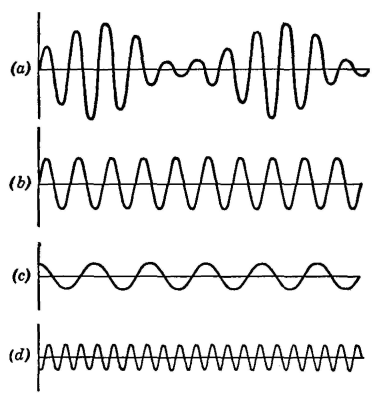| Electrical Communication is a free textbook on the basics of communication technology. See the editorial for more information.... |

|

Home  Telephone Toll Service and Systems Telephone Toll Service and Systems  Analysis of an Amplitude- Modulated Wave Analysis of an Amplitude- Modulated Wave |
|||
| See also: Type C Carrier Telephone Systems | |||






|
|||
Analysis of an Amplitude-Modulated WaveBy definition1, modulation28 is the "process whereby the amplitude (or other characteristic) of a wave is varied as a function of the instantaneous value of another wave. The first wave, which is usually a single-frequency wave, is called the carrier wave; the second wave is called the modulating wave. In amplitude modulation the amplitude of the impressed carrier wave is caused to vary in accordance with the voice-frequency modulating wave to be transmitted. A portion of an amplitude-modulated output wave (of the type transmitted in radio-broadcast systems, page 489) is shown in Fig. 17(a). The modulating signal is a sinusoidal wave, such as a 1000-cycle tone.
The instantaneous magnitude of a sinusoidal current wave is
In amplitude modulation, the value of Im of a carrier-frequency wave ωc = 2πfc is caused to vary in amplitude by a voice-frequency signal wave of frequency fv in accordance with the relation
where Ic is the maximum value of the unmodulated carrier wave, m is the percentage modulation, and ωv = 2πfv. Substituting equation 2 in equation 1 and writing ωc for ω gives, as the instantaneous value of an amplitude-modulated wave such as Fig. 17 (a),
From trigonometry, sin ωvt sin ωct = 0.5*cos (ωc - ωv) t - 0.5*cos (ωc + ωv)t, and if these substitutions are made equation 3 becomes
This is the equation for an amplitude-modulated wave such as shown in Fig. 17 (a), and the equation shows that this wave contains three components as follows: first, a carrier-frequency component, Ic sin ωct which is not affected by the modulation process and is shown by Fig. 17(b); second, the lower sideband,1 0.5*mIccos(ωc - ωv)t, of maximum amplitude mIc/2 and frequency (ωc/2π - ωv/2π) or (fc - fv), and as shown by Fig. 17(c); third, the upper sideband,1 mIc/2*cos(ωc + ωv), of maximum amplitude mIc/2 and frequency (ωc/2π + ωv/2π) or (fc + fv), and as shown by Fig. 17 (d). It is important to note that, in amplitude modulation, sum frequencies (fc + fv) and difference frequencies (fc - fv) are created. The preceding analysis and Fig. 17 are for amplitude modulation by a single-frequency wave. In this instance the sidebands (more correctly, side frequencies) also will be single-frequency waves. For example, if the carrier frequency is 10,000 cycles, and the modulating frequency is 1000 cycles, the lower side frequency will be a single frequency of 9000 cycles, and the upper side frequency will be a single frequency of 11,000 cycles. If the carrier frequency is 10,000 cycles and the modulating frequency is a telephone conversation that is contained within a band of from 200 to 3500 cycles, then the lower sideband will be a complex wave lying within the band 9800 to 6500 cycles, and the upper sideband will lie within the band 10,200 to 13,500 cycles. It is important to note that in amplitude modulation two sidebands are created and that each of these varies in accordance with the modulating signal and contains all the information of the telephone conversation to be transmitted. The component of carrier frequency is unchanged by the amplitude-modulation process and contains no information. The idea that the component of carrier frequency, or "carrier," as it is usually called, in some way "carries" the information to the distant station is incorrect. In fact, most carrier telephone systems and many radio systems suppress the carrier and one sideband and transmit only one sideband to the distant station.
|
|||
Home  Telephone Toll Service and Systems Telephone Toll Service and Systems  Analysis of an Amplitude- Modulated Wave Analysis of an Amplitude- Modulated Wave |
|||
Last Update: 2011-06-05






